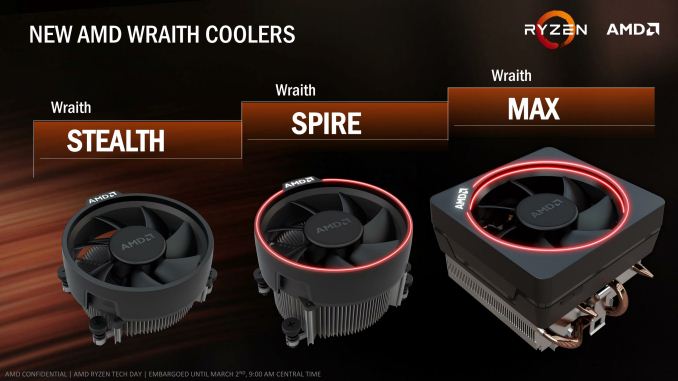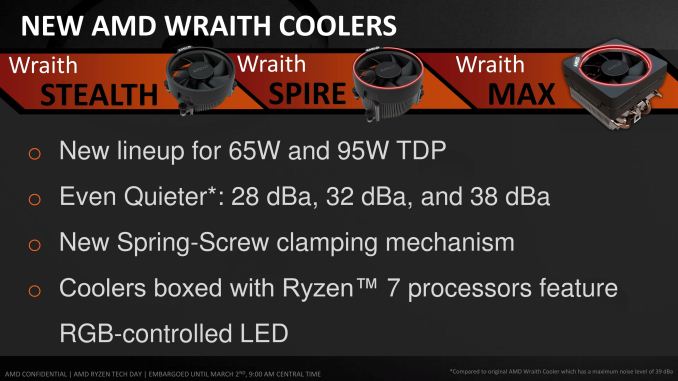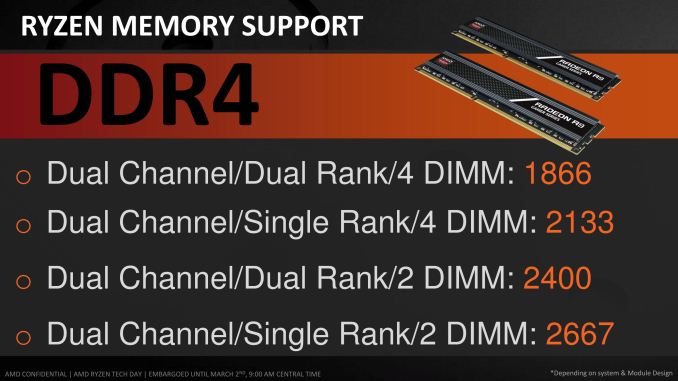The AMD Zen and Ryzen 7 Review: A Deep Dive on 1800X, 1700X and 1700
by Ian Cutress on March 2, 2017 9:00 AM ESTAMD Stock Coolers: Wraith v2
When AMD launched the Wraith cooler last year, bundled with the premium FX CPUs and highest performing APUs, it was a refreshing take on the eternal concept that the stock cooler isn’t worth the effort of using if you want any sustained performance. The Wraith, and the 125W/95W silent versions of the Wraith, were built like third party coolers, with a copper base/core, heatpipes, and a good fan. In our roundup of stock coolers, it was clear the Wraith held the top spot, easily matching $30 coolers in the market, except now it was being given away with the CPUs/APUs that needed that amount of cooling.
That was essentially a trial run for the Ryzen set of Wraith coolers. For the Ryzen 7 launch, AMD will have three models in play.
These are iterative designs on the original, with minor tweaks and aesthetic changes, but the concept is still the same – a 65W near silent design (Stealth), a 95W near silent design (Spire), and a 95W/125W premium model (Max). The 125W models come with an RGB light (which can be disabled), however AMD has stated that the premium model is currently destined for OEM and SI designs only. The other two will be bundled with the CPUs or potentially be available at retail. We have asked that we get the set in for review, to add to our Wraith numbers.
Memory Support
With every generation of CPUs, each one comes with a ‘maximum supported memory frequency’. This is typically given as a number, with the number aligning with the industry standard JEDEC sub-timings. Technically most processors will go above and beyond the memory frequency as the integrated memory controller supports a lot more; but the manufacturer only officially guarantees up to the maximum supported frequency on qualified memory kits.
The frequency, for consumer chips, is usually given as a single number no matter how many memory slots are populated. In reality when more memory modules are in play, it puts more strain on the memory controller so there is a higher potential for errors. This is why qualification is important – if the vendor has a guaranteed speed, any configuration for a qualified kit should work at that speed.
In the server market, a CPU manufacturer might list support a little differently – a supported frequency depending on how many memory modules are in play, and what type of modules. This arguably makes it very confusing when applied at a consumer level, but on a server level it is expected that OEMs can handle the varying degree of support.
For Ryzen, AMD is taking the latter approach. What we have is DDR4-2666 for the simplest configuration – one module per channel of single rank UDIMMs. This moves through to DDR4-1866 for the most strenuous configuration at two modules per channel with dual-rank UDIMMs. For our testing, we were running the memory at DDR4-2400, for lack of a fixed option, however we will have memory scaling numbers in due course. At present, ECC is not supported ECC is supported.













574 Comments
View All Comments
EchoWars - Thursday, March 2, 2017 - link
No, apparently the failure was in your education, since it's obvious you did not read the article.Notmyusualid - Friday, March 3, 2017 - link
Ha...sharath.naik - Thursday, March 2, 2017 - link
I think you missed the biggest news in this information dump. The TDP is the biggest advantage amd has. Which means that for 150watt server cpu. they should be able to cram a lot more cores than intel will be able to.Meteor2 - Friday, March 3, 2017 - link
^^^This. I think AMD's strength with Zen is going to be in servers.Sttm - Friday, March 3, 2017 - link
Yeah I can see that.UpSpin - Thursday, March 2, 2017 - link
According to a german site, in games, Ryzen is equal (sometimes higher, sometimes lower) to the Intel i7-6900K in high resolution games (WQHD). Once the resolution is set very low (720p) the Ryzen gets beaten by the Intel processor, but honestly, who cares about low resolution? For games, the probably best bet would be the i7-7700K, mainly because of the higher clock rate, for now. Once the games get better optimized for 8 cores, the 4-core i7-7700K will be beaten for sure, because in multi-threaded applications Ryzen is on par with the twice expensive Intel processor.I doubt it makes sense to buy the Core i7-6850K, it has the same low turbo boost frequency the 6900K has, thus low single threaded performance, but at only 6 cores. So I expect that it's the worst from both worlds. Poor multi-threaded performance compared to Ryzen, poor single threaded performance compared to i7-7700K.
We also have to see how well Ryzen can get overclocked, thus improving single core performance.
fanofanand - Thursday, March 2, 2017 - link
That is a well reasoned comment. Kudos!ShieTar - Thursday, March 2, 2017 - link
Well, the point of low-resolution testing is, that at normal resolutions you will always be GPU-restricted. So not only Ryzen and the i7-6900K are equal in this test, but so are all other modern and half-modern CPUs including any old FX-8...The most interesting question will be how Ryzen performs on those few modern games which manage to be CPU-restricted even in relevant resolutions, e.g. Battlefield 1 Multiplayer. But I think it will be a few more days, if not weeks, until we get that kind of in-depth review.
FriendlyUser - Thursday, March 2, 2017 - link
This is true, but at the same time this artificially magnifies the differences one is going to notice in a real-world scenario. I saw reviews with a Titan X at 1080p, while many will be playing 1440p with a 1060 or RX480.The test case must also approximate real life.
khanikun - Friday, March 3, 2017 - link
They aren't testing to show what it's like in real life though. The point of testing is to show the difference between the CPUs. Hence why they are gearing their benchmarking to stress the CPU, not other portions of the system.